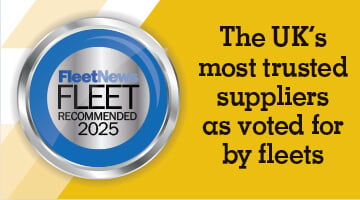Advertisement feature from Hitachi

Every fleet in the UK has to make the journey to electrify and decide whether electric vehicles (EVs) should be added to its choice lists.
The challenges posed by the pandemic over the past 12 months have been the catalyst to truly kick-start the electric ‘revolution’.
The direction of travel has taken focus from the Government’s decision to introduce a ban on the sale of new internal combustion engine (ICE) vehicles by 2030. This nine-year timescale means there are only around two replacement cycles left to ensure businesses are fit for an electric future.
The fact the Government reduced the plug-in car grant overnight just after this year’s Budget by £500 down to £2,500, gives even further stimulus for fleets to take advantage of available funding while it’s still here.
EVs priced at more than £35,000 are now also excluded from the grant funding, but there are still around 40 different models that continue to qualify. The Government says these changes are expected to allow the funding to last longer and be available for more drivers, reflecting the growth in the number of more affordable electric cars.

So how do fleets decide how and when to transition?
Mike Nugent, Head of Intelligent Fleet Decarbonisation for Hitachi, says: “Fleet managers know they need to electrify their fleet, but not necessarily how to go about it.
“The choice of EVs and charge points is confusing and knowing what to do first is a challenge. EVs are more expensive than ICE models, so understanding how to make savings over time is important.”
Hitachi and Hitachi Capital Vehicle Solutions (HCVS) are pioneering decarbonisation solutions for UK fleets with a total turnkey solution for fleets who want to begin the shift away from ICE but are looking for help to make the right investment decisions. Both companies are also partnering with Optimise Prime, an Ofgem-funded innovation project which is the world’s largest trial of commercial EVs.
With more than 30 years of fleet management experience, the team can support clients in mitigating risk, accessing funding, and helping them better understand the evolution of EV technologies, while also allowing them to utilise Hitachi’s data platform and integrated software solutions.
Hitachi and HCVS use data and a consultative approach to hold up a magnifying glass to fleet operations. For them, it’s about finding the best way to move forward with EVs.
Hitachi and HCVS have developed a total cost of ownership (TCO) model and process, designed to help clients understand which vehicles to replace and which depots and workplaces to electrify first.
This includes designing a charging infrastructure to meet their specific requirements and showing the return on investment they can expect over time.
Being able to prove the cost benefits over time is particularly important for fleets, especially given the higher up-front costs for some EVs that don’t have price parity with ICE equivalents.
There are cost savings for drivers on benefit-in-kind (BIK) taxation, but Nugent estimates there are also further efficiencies to be found with up to a 20% reduction in operational maintenance costs through predictive service, maintenance and repair (SMR) scheduling. Costs for EV maintenance are generally lower than for ICE vehicles.
Nugent say it’s important for Hitachi to set its own decarbonisation goals and as a company it has pledged to reduce its carbon emissions by 80% by 2030. Separately, HCVS will transition its car and small van fleet to electric by 2030.
“It’s our number one strategic priority to accelerate fleet decarbonisation,” says Jon Lawes, Managing Director of HCVS. ‘This is one of the toughest challenges fleet operators will ever face and so we’ve partnered with Hitachi to develop a total solution that makes it easier for fleets of all sizes and complexity to decarbonise business mobility and optimise TCO.
Hitachi is also a principal partner at the global climate change conference COP26 being held in Glasgow this November. In the lead-up to COP26, the UK has set some of the most ambitious climate targets, with the aim of cutting UK carbon emissions by 78% by 2035.
Electrification of transport will play a major part to help dramatically reduce carbon to that extent.
Nugent adds: “We are at a crossroads and the decisions we make in 2021 will determine not just the road ahead, but also the timescale and nature of the destination we reach.
“Just look at the growth in private EV sales (up 88.2% in March 2021) – we’ve really seen a major uptick in the past six months, no doubt driven by people re-evaluating their commute and preferred mode of transport.
“Today we are looking even further,” says Nugent. “Once the fleet has been converted, how do you manage battery life cycles and improve the utilisation of your assets? The depot itself can be an asset when we think about the source of the electric energy. The depot can become a revenue generation source by providing carbon neutral solutions such as battery charging, solar and wind generation to create energy onsite. For Hitachi Euorpe this isn’t just about charging points or even the EVs, it is an end-to-end solution giving commercial and public vehicle operators a clear path towards a greener, more sustainable long-term future.
“Decarbonisation is really just the first step of the journey. We’ve still got a long road ahead, but the journey is exciting – and our goal is to make the destination even better.
The electrification and digitisation of vehicle fleets isn’t just important for the companies that manage and rely on them, it will also have a significant impact on how we all live our lives.”
This is part of a much greater whole of what Hitachi and HCVS are trying to achieve. The social innovation behind such projects is just one element of an ongoing discussion.
To learn more about the process and meet the Hitachi team visit https://social-innovation.hitachi.com/portfolio/intelligent-fleet-decarbonisation-emea/.
You can also find out more about Hitachi Capital Vehicle Solutions Fleet Electrification solutions here















Login to comment
Comments
No comments have been made yet.